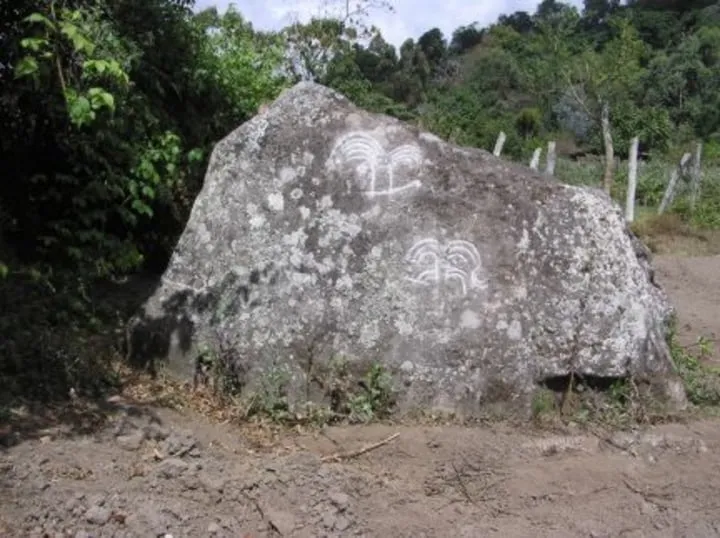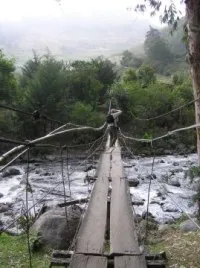The Castillo petroglyph may be unique in the world.
Petroglyphs carved on a rock in the small community of Nueva Suiza, Chiriqui, are unique as they have a possible date and explanation

Petroglyphs carved on a rock in the small community of Nueva Suiza, Chiriqui, are unique as they have a possible date and explanation

The CASTILLO petroglyphs are located a few miles North East of Volcan, in Chiriqui Province,Panama.
The dictionary defines a picture as: “A representation on a flat surface.” The Castillo petroglyph, in Nueva Suiza, Chiriqui, qualifies for that – and the carvings may also qualify as Panama’s oldest pictures.
Sometime, about 550 years ago, a rock carver stood in awe as the mighty Baru Volcano in Chiriqui started to blow its top. We can deduce exactly where he stood, and we know exactly what he depicted. Who he, or she was – of course we don’t know. This was a cataclysmic event and had to be recorded. They couldn’t paint a picture, so they did the next best thing – they took some rough tools and carved what they saw.


I had visited this petroglyph before, but failed to closely observe the opposite side. My second visit showed a side which was far more revealing. To access this remarkable stone you literally have to take your life into your hands. It lies ten minutes north of Volcan down a rough country road. First you have to cross two bridges made of rusting tin and rotten wood – at least these can support a vehicle(just) Then the test of your metal really comes to the fore – you have to cross a 100 foot wire stayed bridge that hangs precariously 20 feet over the rocks of the raging Chiriqui river.
My guide on this trip was local restaurateur Gladys Castillo. Her sister Olga owns the land where the rock is situated. Gladys nimbly crossed the bridge leaving me to contemplate the rotten and splintered boards that barely pass for the bridge deck.
This I thought was foolhardy and extremely dangerous. Trust me these boards could give out at any minute and result in a fall onto the boulders below which surely would break your legs, and most probably kill you. Still I thought, I am a journalist - we are brave, adventurous, and most of us are crazy as a fox. Gingerly I crossed the river in pursuit of the disappearing Gladys Castillo.
On the other side of the bridge I met Olga Castillo – the sister of Gladys. She led me through a gate and up to a corner of a field where a large rock sat next to the hedge. The rock was about twelve feet in length, six feet across and about eight feet high. It looked remarkably like a sacrificial stone I had found in Nicaragua.

On the North side were four spiral circles, some six inches in diameter and joined by a series of interconnecting straight lines. To the bottom left of this side were small round one inch diameter indentations. Another striking aspect was in the top right corner. Here there were several vertical striations emanating from the top of the rock. This gave me the clue that these were possibly artists renditions of lava flows

This rock was not as high as the sacrificial stone I had seen In Nicaragua – that stone was just over four feet high, this rock was twice that height. (trying to perform un-elected surgery here would be very difficult)
The stone carver has made two eruption pictures, one, slightly smaller than the other. The larger carving, above and to the left, is possibly a stone recording of the main event. An explosion and eruption so huge that it wiped out the majority of the local population.
The rock is in effect a three dimensional copy of the Volcano. In ancient times lava would have flowed from the summit – hence the vertical striations at the top. The circles may well represent the pools of lava that gathered and then poured stream-like down the sides and finally the small holes at the bottom would represent the many springs that are still to be found all over this huge feature.
The mountain would have been both a taker of life with its scorching lava and also a provider of it with its streams of life sustaining water. According to National Geographic there was a huge earthquake and volcanic eruption in this area around the year 1450. The lake at the top of the Baru Volcano broke through the mountainside and lava and scalding water cascaded down.
The “Castillo” stone is not in any guide book or on any tourist map, however it is accessible by those of the “crazy like a fox” persuasion. Contact Gladys Castillo at the Castillo Restaurant (on the Cerro Punta road) in Volcan, and she will happily direct you to her sisters property. Bring a camera, a good pair of hiking boots, a two dollar donation, but leave your fear of heights and dangerous bridges behind.
For rock carving enthusiasts and amateur archeologists, a full collection of free pictures of this and other petroglyphs are available at: https://yourpanama.com/images-petroglyphs
If you are an archeologist and would like to see the Castillo Glyph, email me at: